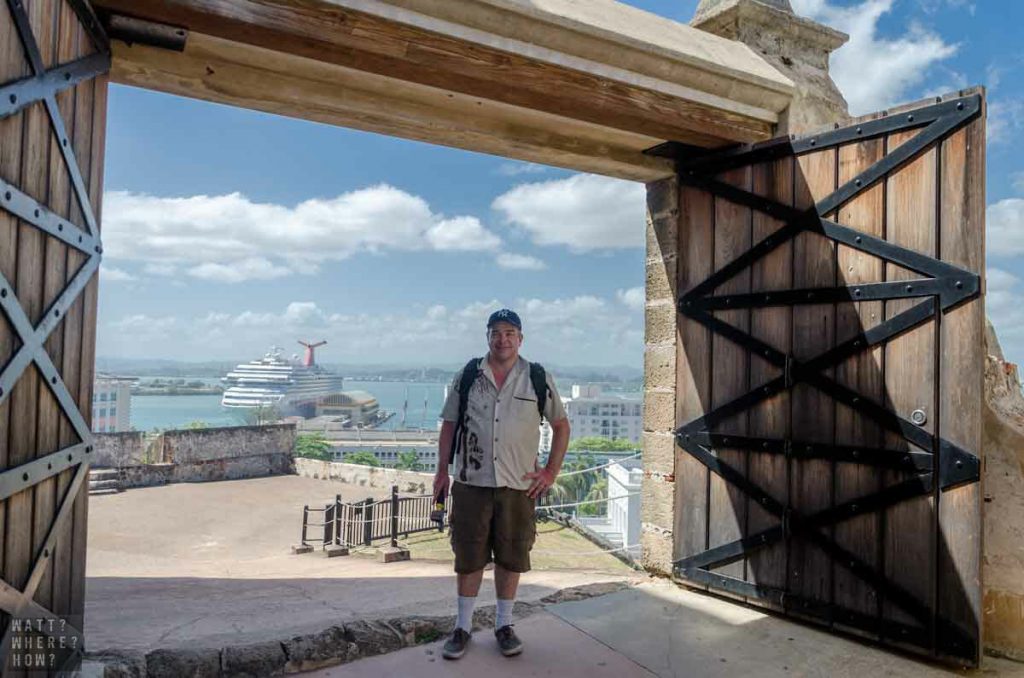Its cannons may inspire imagery of marauding pirates, but the Castillo De San Cristobal has played a strictly defensive role in protecting the tropical walled city of San Juan.
Finished in 1783, the baroque fort, Castillo De San Cristobal, is the largest fortification built by the Spanish in the new world.
The stronghold of Castillo De San Cristobal overlooks the whole of Old San Juan from the beaches of Condado to the other fortress, the Castillo San Felipe del Morro. It was built as a land defense protecting what was originally the city gates when the town was completely walled. The Dutch attacked the city in 1625 and soon after, in 1634 work began on a fort to protect San Juan from future attacks.

Construction
Between 1765 and 1783 heavy construction turned the 27 acres of high ground, 150FT above sea level into an impregnable fort. It didn’t take long for it to be tested by a real land attack. The British, led by Sir Ralph Abercombe were repelled before they even got to San Cristobal. In 1855, the action happened within the walls, with soldiers manning the fort holding a mutiny against the Spanish crown. Luckily it was all over in 24 hours.

Castillo De San Cristobal’s final act of defiance was in 1898, during the Spanish-American War, when it fought back against American battleships, hurling ancient cannon fire towards the flotilla. By then, its dated battery could not match the American firepower and the fort surrendered. Six months later, Puerto Rico became a territory of the United States of America. The fortress was also used as a training facility for artillery teams in World War 2.
Built over three levels, the protected site is accessed by a long ramp from the street level. The first floor houses the main plaza and access to the tunnels. The second level housed soldiers and the firing battery and the top-level served as an impressive observation station, with a 360-degree panoramic view of the city, sea, and land allowing for advanced warning against attacks.

Approaching the ramp from street level, you will notice the garitas, little guard boxes that dot the walls of the citadel. They’re the symbol of Old San Juan and though cute and appealing as a photo opportunity, they’re treated as public urinals by drunken locals (and tourists) – yuk!

On the main plaza you will find the Spanish cisterns that provided a source of fresh water in case of sieges. In more recent years, they have been used as air raid shelters. Some rooms adjoining the courtyard have been set up as museum exhibits. Soldiers’ quarters from the garrison days hold recreations of the beds and uniforms, while the more eagle-eyed visitor may spot original graffiti on the shutters dating back to the 1780s.


The Tunnels
Escape the heat by venturing into the tunnels. The narrow, darkened passages weave through the inner earthworks, housing powder kegs through to dungeons. Most notable is the cell featuring prisoners’ sketches of tall ships – daydreaming of an escape back to the mother country, Spain.

Garita del Diablo
Out of all the garita looking out over the sea, the Garita del Diablo (Sentry Box of the Devil) offers the most intrigue. The local legend was that guards disappeared from it whilst on guard duty. Whether they fell to their deaths or used the remote position to escape and go AWOL, we’ll never know, but it makes for a great photo.

The outer area, known as the outworks is a grassy area overlooking the San Juan Capitol building. In the distance, a salty hazy distorts the view of Condado. Towering piles of ancient cannonballs (weighing up to 200lbs each) attract kids and parents alike. A strong gust offsets the tropical temperatures. Be sure to wear plenty of sunscreen and to reapply – the sun is blisteringly hot around here.

To experience Castillo De San Cristobal and its 200-year history, allow at least an hour. Tickets are only $5. Keep them to also get into the other main fortress, the Castillo San Felipe del Morro. Guided tours are available and we’d recommend the tunnel tour to get the best understanding of what life was like there in the 1700s.
Bernie and Jess Watt are Australian travel bloggers living in NYC. Check out more travel ideas across the Caribbean.
WHAT?
The Castillo De San Cristobal is one of Old San Juan’s original defensive fortresses, built to protect the city gates from inland attack.
WHERE?
San Juan, 00901, Puerto Rico
HOW?
Hours: Open daily from 9:00am – 6:00pm
Entry Fee:
- Children 15 and under: Free
- Adults 16 and older: $5
Keep your ticket as it guarantees you free entry to the other main fort, San Filipe Del Morro.
Follow & Connect with us












